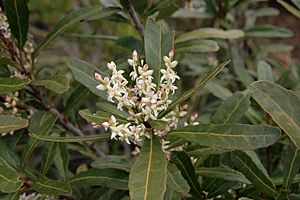Port Arthur plum facts for kids
Quick facts for kids Port Arthur plum |
|
|---|---|
 |
|
| Scientific classification | |
| Genus: |
Cenarrhenes
|
| Species: |
nitida
|
The Cenarrhenes nitida, also known as the Port Arthur plum or native plum, is a special type of plant. It's the only species in its group, called Cenarrhenes. This plant is an evergreen shrub or small tree, meaning it stays green all year round. You can only find it in the rainforests and scrublands of western Tasmania, which makes it unique to that area. It grows white flowers in late spring, and then these flowers turn into tasty-looking, fleshy fruits.
Contents
What's in a Name?
A French scientist and explorer named Jacques Labillardière first described the Port Arthur plum in 1805. He found it in Tasmania, which was then called Van Diemen's Land. The plant still has its common name today.
The name Cenarrhenes comes from two old Greek words: kenos, meaning "empty," and arrhen, meaning "male." This name refers to some small, empty, male-like parts of the flower. The second part of its scientific name, nitida, is a Latin word meaning "bright" or "shining." This describes its glossy, shiny leaves.
Scientists have studied the Port Arthur plum to understand its family tree. Even though it looks a bit like other plants called persoonias, it's not closely related to them. Instead, it's grouped with other plants found in Australia and New Caledonia. More recent studies show it's most closely related to plants from New Caledonia and Madagascar.
The common names for this plant are Port Arthur plum and native plum.
What Does It Look Like?
Leaves and Size
The Port Arthur plum can grow as a tall shrub or a small tree. In places where it's protected, like rainforests, it can reach about 10 meters (33 feet) tall. In more open, windy spots, it might only grow to about 2 meters (6.5 feet).
Its leaves are thick and dull, usually about 8 to 12 centimeters (3 to 5 inches) long. They don't have hairs and have a neat, saw-like edge with a rounded tip. If you crush the leaves, they have a strange smell, a bit like old cabbage. This smell helps tell it apart from a similar-looking plant called native laurel, which doesn't have the smell. When the leaves dry out, they turn black.
The Plum-like Fruit
The fruit of the Port Arthur plum looks a lot like the plums you might eat from the grocery store. That's why it's called a "plum"! These fruits are fleshy and usually about 1.5 centimeters (0.6 inches) big, but they can grow up to 3 centimeters (1.2 inches). They have smooth, deep purple skin. Inside, the flesh is pinkish-white and can be eaten, but it tastes a bit chalky. Just like a regular plum, it has a large hard stone in the middle.
The fruit also has a groove running down one side and a fine, dusty layer on its skin, which gives it a bluish color. This dusty layer can be easily rubbed off. The fruits ripen in autumn, usually from March to May.
Pretty White Flowers
The flowers appear in early summer, from November to December. They are small, symmetrical, and don't have a strong scent. Each flower has four pointed, fleshy petals that curl backward when they open. When the flowers are still buds, their tips are pink, but they turn completely white when they open up.
These flowers don't have stalks and grow on woody spikes that are shorter than the leaves. Insects help pollinate the flowers. Each flower has four thick, creamy-yellow parts called stamens. The pollination process is quite clever: it's "spring-loaded" and gets triggered when a touch-sensitive hair on one of the stamens is touched. Often, only 1 to 3 flowers on each spike will grow into mature fruit, while the others might form small, woody balls.
Where Does It Grow?
The Port Arthur plum is found only in southern and western Tasmania and some of its nearby islands. It can grow up to 800 meters (2,600 feet) high, which is near the edge of the alpine zone (where it starts to get very cold and high up).
You'll often find it growing as a small shrub or tree under taller trees in wet forests and rainforests, especially where the soil isn't very rich. Sometimes, it also grows in open areas like heathlands, button grass fields, and scrublands. You can also find populations of this plant on Bruny Island and the Maatsuyker Islands, where the environment is similar to mainland Tasmania.
How to Grow Your Own
The Port Arthur plum is a slow-growing plant. If you want to grow it, it needs a cool, moist, and shady spot. The soil should have lots of compost and drain well.
To grow it from seeds, you first need to remove the fleshy part of the fruit and let the hard stone dry. You can store the seeds this way as long as they are kept in a place with good air circulation. For the seeds to sprout, they need to be kept cold for at least two months (this is called "stratification") and then be at a temperature of about 20°C (68°F).
Growing Port Arthur plum can be tricky and slow if the conditions aren't just right. It's usually best to grow them from seeds. Cuttings (pieces of the plant) might stay green for a long time without growing roots before they eventually turn brown.


